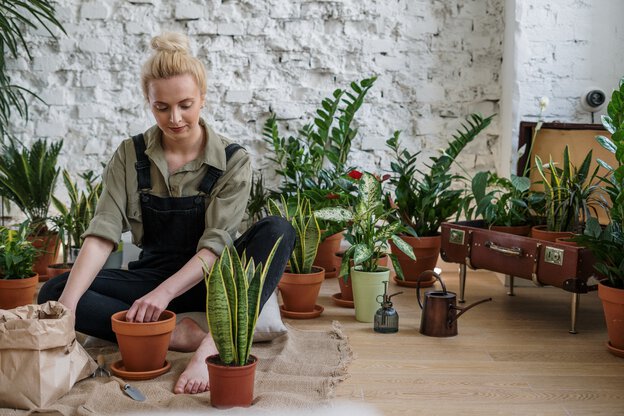Renter guide to indoor gardening
Having many indoor plants while renting may seem an impossible task. However, you can have your own low-maintenance indoor jungle with the proper research and preparation!
In recent studies, it has been proven that indoor plants have various significant physical and mental benefits.
Firstly, plants improve your air quality by purifying the air; even just one large houseplant can improve the air quality by up to 25%!
Secondly, plants can reduce anxiety and depression, with a recent Sydney-based study revealing plants brought feelings of anxiety and tension down by nearly 40% and depression down by 60% amongst participants.
Moreover, indoor plants have also proven to increase productivity, motivation and memory retention!
So, with all these various health benefits in mind, how can you start your own indoor jungle in your rental home? Here are our 5 top tips for owning a thriving rental garden:
1. Find the right rental property & plan your space
When inspecting your potential future rental home, keep an eye out for features that would assist with having plants. For instance, check tap locations and ease of access for watering, check the courtyard/balcony/outdoor space and measure to have an idea of the space you’re working with.
If you have a lot of plants or large plants that are difficult to move, consider the length of lease. You might be able to negotiate a longer term lease, longer notice period or even minor modifications to the rental property to make your space a happy home for plants eg. a wall planter
You need to ask yourself a few key questions when planning which plants to buy: How much light do you have? How much space do you have for plants - where would they go in your home? What plants attract you the most; edibles or attractive foliage on indoor plants? For instance, if you have limited light and space inside but a sunny balcony - consider edibles such as herbs or easy to grow veggies.
Check out Better Homes & Gardens guide to indoor plants & easy edibles. Once you have a general idea of what types of plants will best suit your space, you can get ready to purchase them!
2. Buying your new plants
Buy the right plants (support small nurseries or local growers instead of larger hardware retailers) and suitable pots. Generally, make sure every pot has drainage holes, and water can flow freely through the pot when watered.
In your rental home, it’s crucial to ensure that the pot will not stain the ground - whether it’s inside or outside your house. An easy solution is to always keep pots on saucers and regularly clean underneath pots to prevent mould. If you’re planting in an apartment on a balcony, use heavy pots or weights in plants to ensure plants don’t get knocked over by heavy winds!
3. Potting up
Choosing the right potting mix to plant is based on your chosen plants required conditions. For instance, plants from desert regions like succulents require more freely draining soil with additives like gravel or sand. If you’re unsure which potting mix is best, try Googling your plant or referring to this online guide to potting mix.
For extra nutrients for your plants, try setting up a home compost or worm farm - any composted matter can be put in with your plants! As a general rule, edible plants require more nutrients than other plants. Check out the City Of Sydney’s guide to growing edible plants in your rental home.
4. Plant Maintenance
To keep your plants happy, it’s essential to be aware of each plant’s maintenance. This includes a watering schedule, knowing when to repot, managing pests, and trimming (which promotes healthier growth!). If you’re unsure how to look after your plant, there is extensive information online. Take a look at Gardening Australia’s plant search for more information about how to look after your new houseplants.
It’s also important to maintain the rental property by avoiding damage to ensure you receive your full bond back. Make sure there are no water leaks when setting up your garden/indoor plant set up which could be causing damage to the rental property, as well as excessive water bills.
5. Chop & prop: Share the love!
Once your plants have settled into their new home, you can share them with your friends and neighbours! Plant propagation is an easy and sustainable gift for your loved ones. There are many different types of propagation, but the most common ways are cuttings, root division, and leaf propagation. Check out this fun Gardening Australia episode, which walks you through the various ways you can propagate your houseplants.
Good luck with your new indoor jungle & happy renting!
